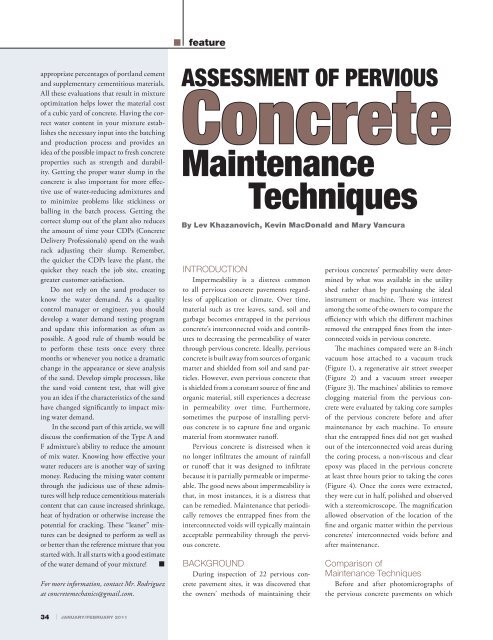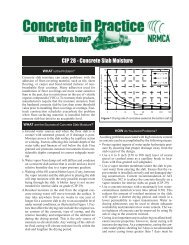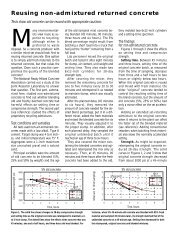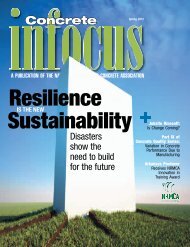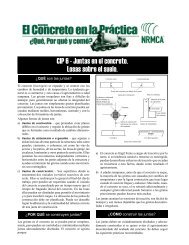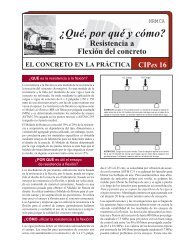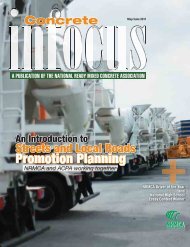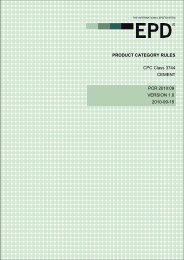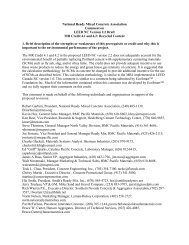2010 NRMCA - National Ready Mixed Concrete Association
2010 NRMCA - National Ready Mixed Concrete Association
2010 NRMCA - National Ready Mixed Concrete Association
You also want an ePaper? Increase the reach of your titles
YUMPU automatically turns print PDFs into web optimized ePapers that Google loves.
featureappropriate percentages of portland cementand supplementary cementitious materials.All these evaluations that result in mixtureoptimization helps lower the material costof a cubic yard of concrete. Having the correctwater content in your mixture establishesthe necessary input into the batchingand production process and provides anidea of the possible impact to fresh concreteproperties such as strength and durability.Getting the proper water slump in theconcrete is also important for more effectiveuse of water-reducing admixtures andto minimize problems like stickiness orballing in the batch process. Getting thecorrect slump out of the plant also reducesthe amount of time your CDPs (<strong>Concrete</strong>Delivery Professionals) spend on the washrack adjusting their slump. Remember,the quicker the CDPs leave the plant, thequicker they reach the job site, creatinggreater customer satisfaction.Do not rely on the sand producer toknow the water demand. As a qualitycontrol manager or engineer, you shoulddevelop a water demand testing programand update this information as often aspossible. A good rule of thumb would beto perform these tests once every threemonths or whenever you notice a dramaticchange in the appearance or sieve analysisof the sand. Develop simple processes, likethe sand void content test, that will giveyou an idea if the characteristics of the sandhave changed significantly to impact mixingwater demand.In the second part of this article, we willdiscuss the confirmation of the Type A andF admixture’s ability to reduce the amountof mix water. Knowing how effective yourwater reducers are is another way of savingmoney. Reducing the mixing water contentthrough the judicious use of these admixtureswill help reduce cementitious materialscontent that can cause increased shrinkage,heat of hydration or otherwise increase thepotential for cracking. These “leaner” mixturescan be designed to perform as well asor better than the reference mixture that youstarted with. It all starts with a good estimateof the water demand of your mixture! ■For more information, contact Mr. Rodriguezat concretemechanics@gmail.com.ASSESSMENT OF PERVIOUS<strong>Concrete</strong>MaintenanceTechniquesBy Lev Khazanovich, Kevin MacDonald and Mary VancuraINTRODUCTIONImpermeability is a distress commonto all pervious concrete pavements regardlessof application or climate. Over time,material such as tree leaves, sand, soil andgarbage becomes entrapped in the perviousconcrete’s interconnected voids and contributesto decreasing the permeability of waterthrough pervious concrete. Ideally, perviousconcrete is built away from sources of organicmatter and shielded from soil and sand particles.However, even pervious concrete thatis shielded from a constant source of fi ne andorganic material, still experiences a decreasein permeability over time. Furthermore,sometimes the purpose of installing perviousconcrete is to capture fi ne and organicmaterial from stormwater runoff.Pervious concrete is distressed when itno longer infi ltrates the amount of rainfallor runoff that it was designed to infi ltratebecause it is partially permeable or impermeable.The good news about impermeability isthat, in most instances, it is a distress thatcan be remedied. Maintenance that periodicallyremoves the entrapped fi nes from theinterconnected voids will typically maintainacceptable permeability through the perviousconcrete.BACKGROUNDDuring inspection of 22 pervious concretepavement sites, it was discovered thatthe owners’ methods of maintaining theirpervious concretes’ permeability were determinedby what was available in the utilityshed rather than by purchasing the idealinstrument or machine. There was interestamong the some of the owners to compare theefficiency with which the different machinesremoved the entrapped fines from the interconnectedvoids in pervious concrete.The machines compared were an 8-inchvacuum hose attached to a vacuum truck(Figure 1), a regenerative air street sweeper(Figure 2) and a vacuum street sweeper(Figure 3). The machines’ abilities to removeclogging material from the pervious concretewere evaluated by taking core samplesof the pervious concrete before and aftermaintenance by each machine. To ensurethat the entrapped fi nes did not get washedout of the interconnected void areas duringthe coring process, a non-viscous and clearepoxy was placed in the pervious concreteat least three hours prior to taking the cores(Figure 4). Once the cores were extracted,they were cut in half, polished and observedwith a stereomicroscope. The magnificationallowed observation of the location of thefi ne and organic matter within the perviousconcretes’ interconnected voids before andafter maintenance.Comparison ofMaintenance TechniquesBefore and after photomicrographs ofthe pervious concrete pavements on which34 ı JANUARY/FEBRUARY 2011


